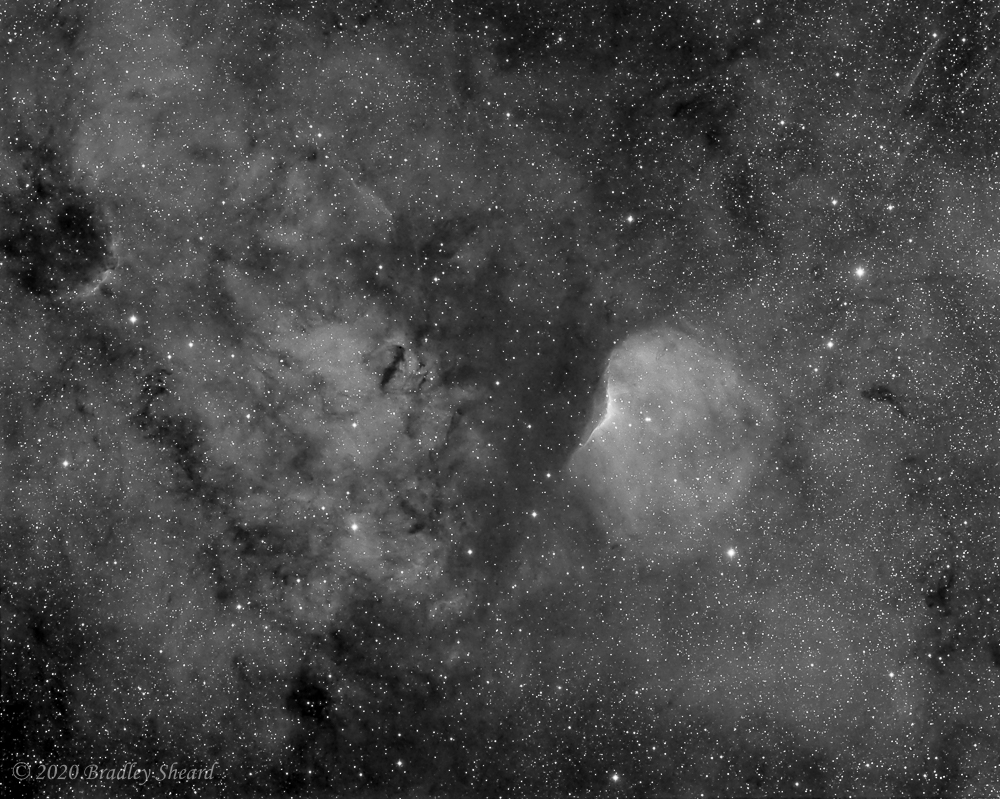Sharpless 2-140 | |||
| « Previous | Back to Astrophotography Gallery | Next » | |
Sharpless 2-140 is a mass of hydrogen gas excited by the type B0V, double star HD 211880 (HIP 110125); the estimated distance to the star is 900 pc (2935 light years). This roughly circular emission nebula is associated with the bordering dark molecular cloud LDN 1204, and the ionizing radiation from the star creates the Bright Rimmed Cloud (BRC) evident on the upper left of the Sh 2-140 nebula. | |||
 | |||
| Optics: | Stellarvue SVQ-100 refractor | ||
| Camera: | Starlight Xpress SX-46 monochrome CCD camera | ||
| Exposure info: | 30 x 20 min subs | ||
| Filters used: | Astrodon H-alpha (5 nm) | ||
| Date: | October 2020 | ||
| Processing: | Pixinsight-->Photoshop-->Lightroom | ||
The image above was taken through a narrowband filter (a filter that allows only a narrow band of light at a very specific wavelength to pass through to the digital camera), specifically a H-alpha filter (hydrogen, 656.3 nm). The bright areas of the image are emitting light at a wavelength of 656.3 nm, which occurs when the electron in an excited hydrogen atom falls from the third to the second orbital, or energy level. The "Bright Rimmed Cloud" (BRC, indicated in the annotated version of the above image) lies on the border between the HII region (Sh 2-140) and the dark molecular cloud (LDN 1204), and represents a kind of shock wave where new star formation is often triggered. | |||
Quoting from Reference 3 below: "When the surface layer of a preexisting molecular cloud is ionized at one side by the ionizing radiation from nearby OB stars, the ionizing heating drives a high-pressure wave propagating into the cold molecular cloud to compress the gas to form a high-density core, which may be the potential site for new star formation. This mechanism for ionizing radiation-triggered star formation in a molecular cloud is called radiation-driven implosion (RDI). When the released electrons recombine with ions around the ionizing-star-facing side of the cloud, electrons frequently downtransition from the second to the first excited state, producing 656.3 nm photons to form a red bright rim around the cloud on that side. The subsequent cloud is called bright-rimmed cloud (BRC)." | |||
Reference 4 describes parts of this region as follows: "The S140 region ia a prototypical cometary globule, photoionized on the southwest side by the BO star HD 211880. It contains at least three bright infrared sources. A high-velocity molecular outflow was detected in 12CO observations by Snell et al. (1984). Previous smaller scale molecular line observations have been made by Minchin, White and Padman (1993), who determined that the outflow was driven by the source IRS 1." "L1206 is a bright-rimmed globule associated with the HII region S145. It has a molecular outflow discovered in a survey by Sugitani et al. (1989)" The infrared sources mentioned above are generally believed to be "embedded early-type stars" (Reference 2). | |||
REFERENCES
1. Kun, Balazs and Toth, "Giant Infrared Bubble in Cepheus." Astrophysics and Space Science 134 (1987), 211-217.
2. Knapp, Brown, Kuiper and Kakar, "Carbon Recombination Line Observations of the Sharpless 140 Region." The Astrophysical Journal, 204:781-788, 1976 March 15.
3. Fukuda, Miao, Sugitani, Kawahara, Watanabe, Nakano and Pickles, "Triggered Star Formation in a Bright-Rimmed Cloud (BRC 5) of IC 1805." The Astrophysical Journal, 773:132, 2013 August 20.
4. Ridge, Wilson, Megeath, Allen and Myers, "A 13CO and C18O Survey of the Molecular Gas Around Young Stellar Clusters within 1 kiloparsec of the Sun." The Astronomical Journal, 126:286-310, 2003 July.